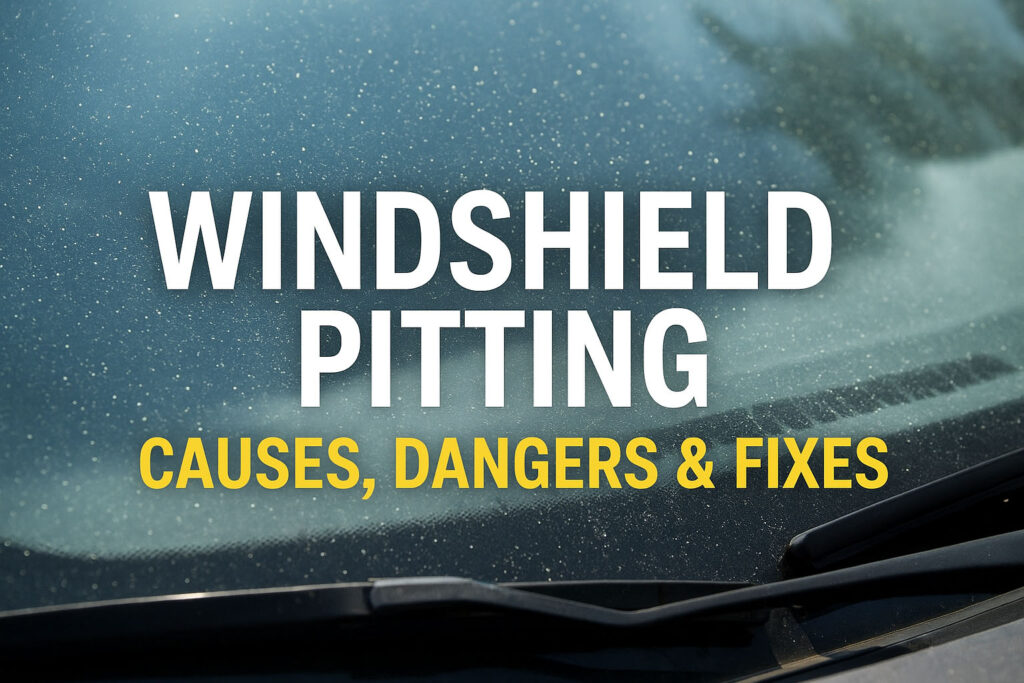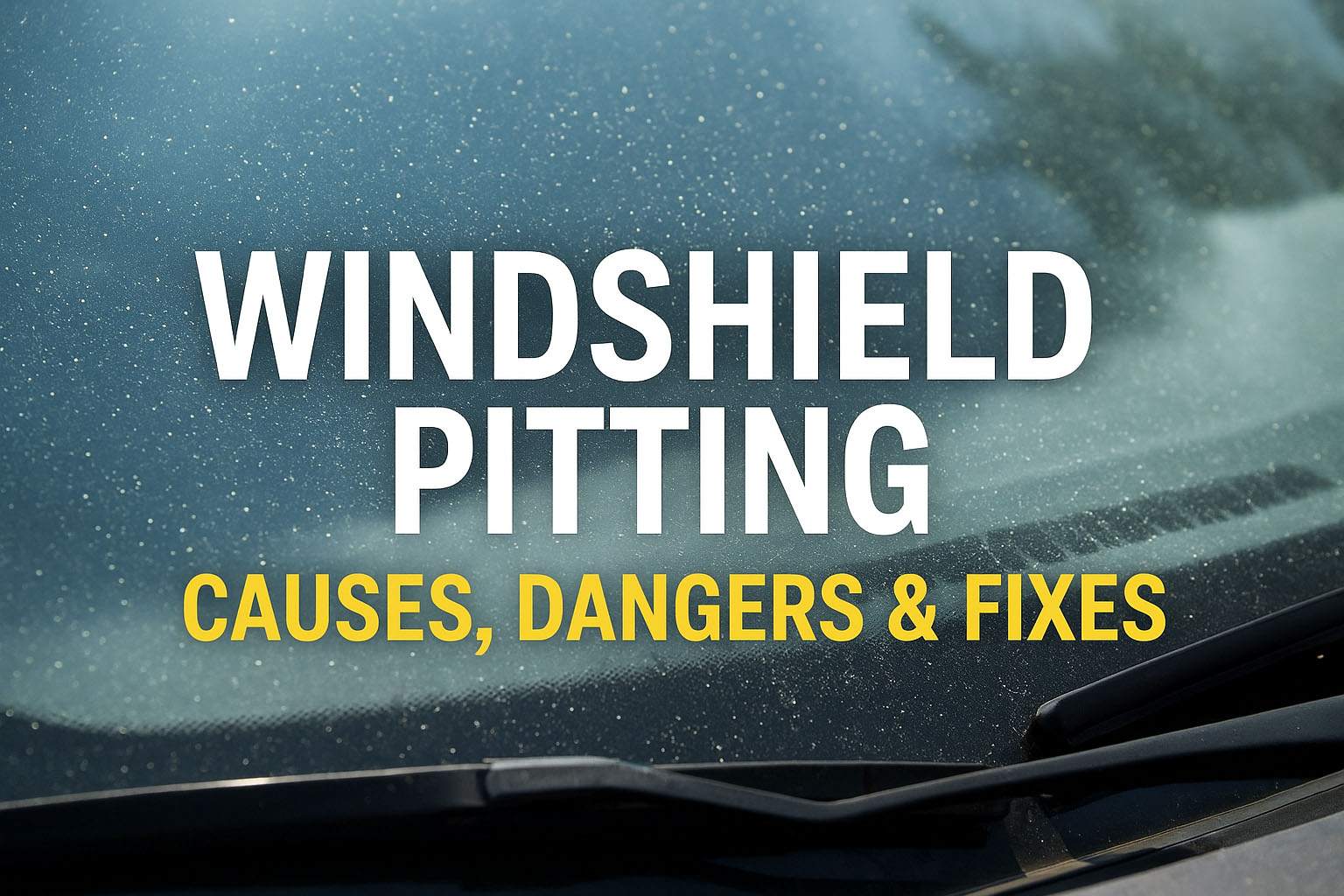What Is Windshield Pitting?
Windshield pitting refers to the small pits, craters, or dimples that develop on the surface of auto glass over time. Unlike chips and cracks caused by a single incident, pitting results from cumulative damage. At first, you might not even notice it. But over time, these tiny imperfections scatter light and distort your view of the road.
A pitted windshield isn’t just unattractive—it can seriously impact safety, which is why understanding its causes and solutions is essential for every driver.
What Causes Windshield Pitting?
Pitting occurs because your windshield faces constant exposure to harsh conditions. Here are the most common causes:
1. Road Debris Impact
Tiny particles like sand, pebbles, and salt hit the glass at high speed, leaving microscopic abrasions. Over months or years, this creates noticeable pitting.
2. High-Speed Driving
Driving at highway speeds increases the force of impact from airborne debris, accelerating the process.
3. Environmental Conditions
- Dust and Sandstorms: Common in desert regions.
- Salt and Chemicals: In snowy areas, road salt can be corrosive when combined with debris.
- Wind and Weather: Strong winds carry abrasive particles that erode the glass surface.
4. Aging and Wear
Older windshields naturally accumulate more pits due to prolonged exposure.
Why Is Windshield Pitting Dangerous?
Pitting creates more than just cosmetic concerns. Here’s why it matters:
1. Reduced Visibility and Glare
- Light Distortion: The uneven surface bends light, causing glare during sunny days, sunrise, or when facing oncoming headlights.
- Water Retention: Tiny craters trap water, making it harder for wipers to clear your view in rain.
- Eye Strain: Constant visual distortion causes fatigue and slows reaction time.
2. Compromised Safety and Structural Integrity
- Weakens Glass: Though pitting alone won’t shatter the windshield, it weakens its surface, making cracks more likely.
- Safety Risks in Accidents: Your windshield provides up to 45% of cabin strength in rollovers and ensures proper airbag deployment. A weakened windshield can fail when you need it most.
Signs Your Windshield Is Pitted Beyond Safe Use
- Persistent glare during daylight or night driving
- Difficulty seeing clearly even after cleaning the windshield
- Uneven light refraction when headlights or sunlight hit the glass
- Noticeable roughness when running your hand over the surface
If you notice these signs, it’s time to consider a replacement.
Can a Pitted Windshield Be Repaired?
Unfortunately, pitting cannot be repaired. Unlike isolated chips or cracks, which can often be filled with resin, pitting affects the entire surface of the windshield.
Why Polishing Isn’t Enough
Some shops offer glass polishing, but this is rarely a long-term solution. Polishing can thin the glass, compromising its strength further. Even after polishing, glare and visibility issues often remain.
Replacement Is the Only Safe Fix
If your windshield is heavily pitted, replacement is the only effective solution. Driving with impaired visibility significantly increases accident risk, especially in bright sun or at night.
The Importance of Proper Windshield Replacement
Not all replacements are equal. Improper installation can lead to leaks, rattling, and even detachment during a crash. Here’s what you should look for:
- Certified Technicians: Ensure they follow OEM (Original Equipment Manufacturer) standards.
- Quality Glass: Avoid substandard glass that doesn’t meet safety specs.
- ADAS Calibration: Many modern vehicles use sensors behind the windshield for features like lane assist or automatic braking. After replacement, recalibration is critical for these systems to work correctly.
How to Find Trusted Shops and Compare Prices
Replacing a windshield can feel overwhelming—but we make it simple. Use our free quote tool to compare prices from up to three trusted auto glass shops near you. This helps you:
- Save money by comparing rates
- Avoid low-quality installations
- Find technicians experienced in ADAS calibration
Click here to get your free windshield replacement quote now!
FAQs About Windshield Pitting
1. How fast does windshield pitting happen?
It depends on driving conditions. Highway driving and dusty environments accelerate pitting, but even in normal conditions, it accumulates over years.
2. Is it illegal to drive with a pitted windshield?
In many states, if the pitting obstructs the driver’s view, it can fail a vehicle inspection and result in a citation.
3. Does insurance cover windshield pitting?
Most insurance policies cover sudden damage like cracks or chips, not gradual wear like pitting. However, some comprehensive plans might help with replacement. Check with your provider.
4. Can I polish the windshield myself to remove pits?
DIY polishing can slightly reduce minor pits, but it won’t restore clarity or strength. It’s not recommended for safety-critical glass like windshields.
5. How much does it cost to replace a pitted windshield?
Costs vary by vehicle make, model, and features like ADAS sensors. Use our free quote tool to get accurate estimates from local shops.
6. Does windshield pitting affect resale value?
Yes. A severely pitted windshield can lower resale value because it signals poor visibility and possible neglect of vehicle maintenance.
Bottom Line
Windshield pitting may seem harmless at first, but over time, it creates serious safety issues by reducing visibility and weakening the glass. Replacement—not repair—is the only real solution. Use our free quote tool to compare up to three trusted shops and restore your safety today.
✅ Get Your Free Windshield Replacement Quote Now

To read more, visit blog.glass.net

